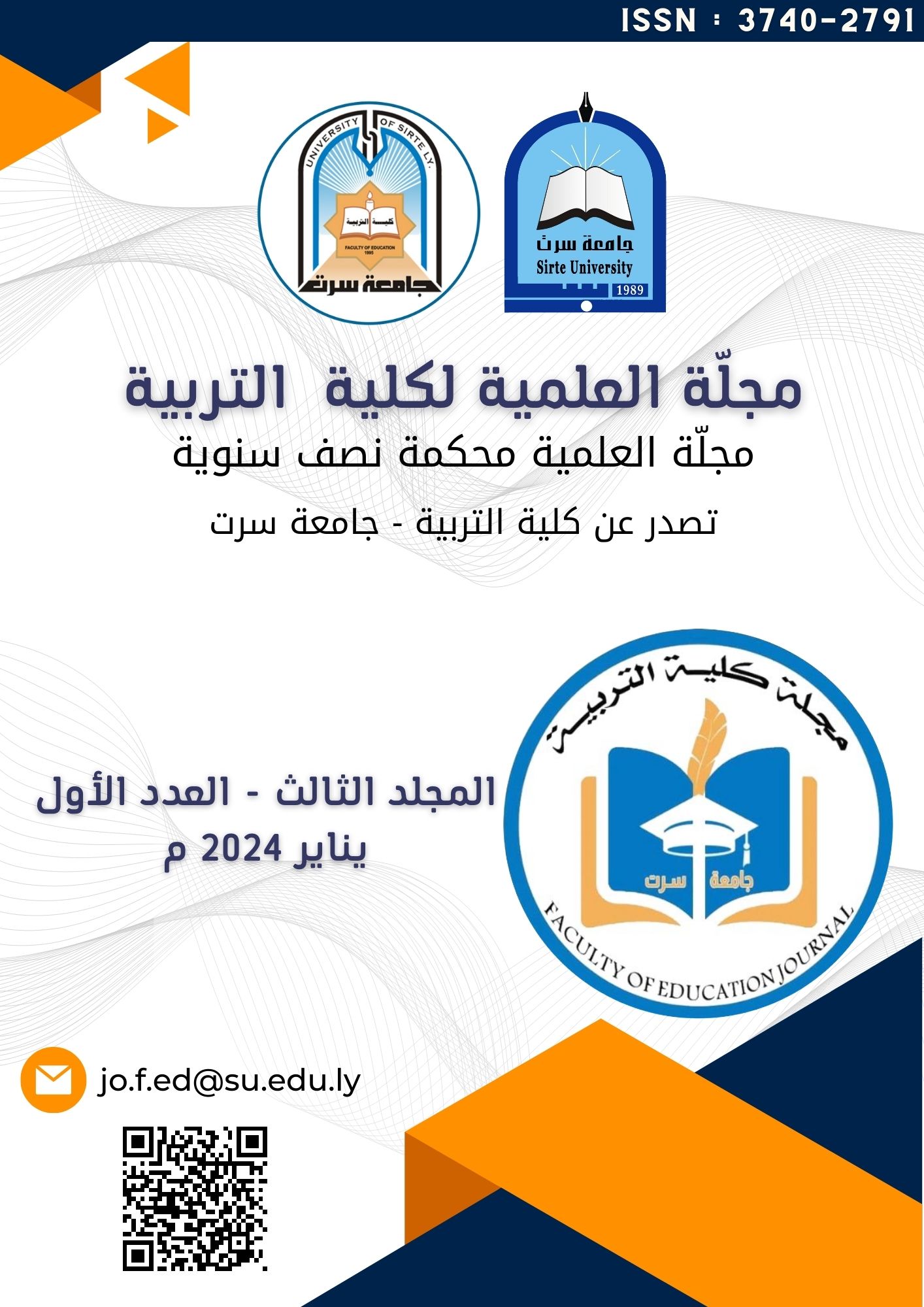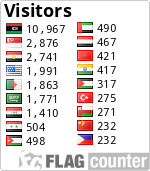A report on the date palm weevil pest and its onset in the city of Tobruk, eastern Libya
DOI:
https://doi.org/10.37375/foej.v3i1.2599الكلمات المفتاحية:
سلوك المستخدم، خوارزمية التصفية التعاونية، اهتمامات المستخدم، الكتب المقترحة، أنظمة التوصيةالملخص
تناولت هذه الدراسة جانباً مهماً وحيوياً في البحث العلمي، ألا وهو موضوع اقتناء مصادر المعلومات كالكتب من مواقع التجارة الإلكترونية، فعندما تكون أنواع الكتب المعروضة على هذه المواقع الإلكترونية كثيرة جدا، يكون من الصعب على المستخدم اختيار الكتب المناسبة له من بين الكم الهائل من الكتب الموجودة التي تزداد أعدادها سنوياً، وهذا ينعكس سلبا على المستخدمين في اهدار كثير من الوقت في اختيار ما يحتاجون منها.
لذلك اتجهت هذه الدراسة للمساهمة في حل هذه المشكلة وذلك بمساعدة المستخدمين في استكشاف واقتناء مصادر المعلومات المناسبة لاهتماماتهم، ذلك من خلال استخدام خوارزمية التصفية التعاونية المبنية على سلوك المستخدم وهي احدى طرق نظم التوصية، وللتحقق من دقة النظام فقد تم استخدام معادلة فرق المسافة لقياس مدى التشابه بين الكتب الموصي بها والكتاب المطلوب.
وتوصلت الدراسة الى مجموعة من النتائج أهمها الحصول على معلومات مفيدة تساعد المستخدمين في اتخاذ القرارات المناسبة لتلبية احتياجاتهم من خلال سلوكهم واقتراح عناصر ذات صلة باهتماماتهم، كما تجنب المستخدم اتخاذ القرارات التي لا تلبي اهتماماته او الغير مرغوب فيها، ومن ثم التنبيه بالاختيارات (القرارات) التي تساعده للوصول الى نتائج أفضل.
ويوصي هذه الدراسة باستخدام خوارزميات أخرى كخوارزمية التوصية باستخدام المحتوى للمقارنة بينها وبين الخوارزمية المعتمدة على سلوك المستخدم، وتوضيح أفضلهما من حيث النتائج.
المراجع
-Abraham, V. A., Shuaibi, M. A., Faleiro, J. R., Abozuhairah, R. A., & Vidyasagar, P. S. (1998). An integrated management approach for red palm weevil Rhynchophorus ferrugineus Oliv. a key pest of date palm in the Middle East. Journal of Agricultural and Marine Sciences [JAMS], 3(1), 77-83.
-Dembilio, Ó., & Jacas, J. A. (2011). Basic bio-ecological parameters of the invasive Red Palm Weevil, Rhynchophorus ferrugineus (Coleoptera: Curculionidae), in Phoenix canariensis under Mediterranean climate. Bulletin of entomological research, 101(2), 153-163.
-Dembilio, Ó., & Jaques, J. A. (2015). Biology and management of red palm weevil. In Sustainable pest management in date palm: current status and emerging challenges (pp. 13-36). Springer, Cham.
-Dutta, R., Thakur, N. S. A., Bag, T. K., Anita, N., Chandra, S., & Ngachan, S. V. (2010). New record of red palm weevil, Rhynchophorus ferrugineus (Coleoptera: Curculionidae) on arecanut (Areca catechu) from Meghalaya, India. Florida Entomologist, 93(3), 446-448.
-Faghih, A. A. (1996). The biology of red palm weevil, Rhynchophorus ferrugineus Oliv.(Coleoptera, Curculionidae) in Saravan region (Sistan & Balouchistan province, Iran). Applied Entomology and Phytopathology, 63(1/2), 16-18.
-Friedman, Matti (2021-02-10). "Opinion | The New Alliance Shaping the Middle East Is Against a Tiny Bug". The New York Times. ISSN 0362-4331. Retrieved 2022-01-05.
-Giblin-Davis, R. M., Faleiro, J. R., Jacas, J. A., Peña, J. E., & Vidyasagar, P. S. P. V. (2013). Biology and management of the red palm weevil, Rhynchophorus ferrugineus. Potential invasive pests of agricultural crops (eds Peña JE), 1-34.
-Hallett, R. H., Crespi, B. J., & Borden, J. H. (2004). Synonymy of Rhynchophorus ferrugineus (Olivier), 1790 and R. vulneratus (Panzer), 1798 (Coleoptera, Curculionidae, Rhynchophorinae). Journal of Natural History, 38(22), 2863-2882.
-Ju, R. T., Wang, F., Wan, F. H., & Li, B. (2011). Effect of host plants on development and reproduction of Rhynchophorus ferrugineus (Olivier)(Coleoptera: Curculionidae). Journal of Pest Science, 84(1), 33-39.
-Khamiss, O., & Badeea, A. A. (2013). Initiation, characterization and karyotyping of a new cell line from red palm weevil Rhynchophorus ferrugineus adapted at 27° C. In Colloque méditerranéen sur les ravageurs des palmiers, Nice, France, 16-18 Janvier 2013. Association Française de Protection des Plantes (AFPP).
-Kurian, C. H. A. N. D. Y., & Mathen, K. (1971). Red palm weevil-hidden enemy of coconut palm. Indian farming, 21(1), 29-31.
-Nirula, K. K. (1956). Investigations on the pests of coconut palm. Part III. Nephantis serinopa Meyrick. Indian Coconut J, 9, 101-131.
-Rajamanickam, K., Christopher, A., & Kennedy, J. S. (1995). Certain components of integrated management for red palm weevil, Rhynchophorus ferrugineus F.(Curculionidae: Coleoptera) on coconut [in South India]. Mededelingen-Faculteit Landbouwkundige en Toegepaste Biologische Wetenschappen Universiteit Gent (Belgium).
-Rugman-Jones, P. F., Hoddle, C. D., Hoddle, M. S., & Stouthamer, R. (2013). The lesser of two weevils: molecular-genetics of pest palm weevil populations confirm Rhynchophorus vulneratus (Panzer 1798) as a valid species distinct from R. ferrugineus (Olivier 1790), and reveal the global extent of both. PloS one, 8(10), e78379.
-Wakil, W., Faleiro, J. R., & Miller, T. A. (Eds.). (2015). Sustainable pest management in date palm: current status and emerging challenges. Springer.
-WATTANAPONGSIRI, A. (1966). A revision of the genera Rhynchophorus and. Dynamis.











